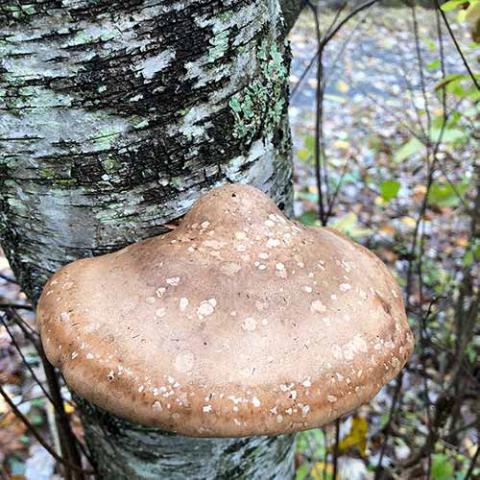NAMES
TAXONOMY
FUNGI ID
THERAPEUTIC
Philatia
Issued:
Stamp:
Fomitopsis betulina
Philatia
Issued:
Stamp:
Fomitopsis betulina
Philatia
Issued:
Stamp:
Fomitopsis betulina
Fomitopsis betulina (formerly Piptoporus betulinus): the Iceman’s polypore fungus with modern biotechnological potential
Authors: Małgorzata Pleszczyńska,corresponding, Marta K. Lemieszek, Marek Siwulski, Adrian Wiater, Wojciech Rzeski and Janusz Szczodrak1 April 4, 2017
Abstract
Higher Basidiomycota have been used in natural medicine throughout the world for centuries. One of such fungi is Fomitopsis betulina (formerly Piptoporus betulinus), which causes brown rot of birch wood. Annual white to brownish fruiting bodies of the species can be found on trees in the northern hemisphere but F. betulina can also be cultured as a mycelium and fruiting body. The fungus has a long tradition of being applied in folk medicine as an antimicrobial, anticancer, and anti-inflammatory agent. Probably due to the curative properties, pieces of its fruiting body were carried by Ötzi the Iceman. Modern research confirms the health-promoting benefits of F. betulina. Pharmacological studies have provided evidence supporting the antibacterial, anti-parasitic, antiviral, anti-inflammatory, anticancer, neuroprotective, and immunomodulating activities of F. betulina preparations. Biologically active compounds such as triterpenoids have been isolated. The mushroom is also a reservoir of valuable enzymes and other substances such as cell wall (1→3)-α-d-glucan which can be used for induction of microbial enzymes degrading cariogenic dental biofilm. In conclusion, F. betulina can be considered as a promising source for the development of new products for healthcare and other biotechnological uses.
Reference: National Center for Biotechnology Information
Personal Observation Information
Reference: iNaturalist.org
Genus species (Fungi): Fomitopsis betulina
Fomitopsis betulina (previously Piptoporus betulinus), commonly known as the birch polypore, birch bracket, or razor strop, is a common bracket fungus and, as the name suggests, grows almost exclusively on birch trees. The brackets burst out from the bark of the tree, and these fruit bodies can last for more than a year.
Taxonomy
The fungus was originally described by Jean Bulliard in 1788 as Boletus betulinus. It was transferred to the genus Piptoporus by Petter Karsten in 1881. Molecular phylogenetic studies suggested that the species was more closely related to Fomitopsis than to Piptoporus, and the fungus was reclassified to Fomitopsis in 2016.
The specific epithet betulina refers to the genus of the host plant (Betula). Common names for the fungus include birch bracket, birch polypore, and razorstrop fungus.
Description
The fruit bodies (basidiocarps) are pale, with a smooth greyish-brown top surface, while the creamy white underside has hundreds of pores that contain the spores. The fruit body has a rubbery texture, becoming corky with age. Wood decayed by the fungus, and cultures of its mycelium, often smell distinctly of green apples. The spores are cylindrical to ellipsoidal in shape, and measure 3–6 by 1.5–2 μm.
F. betulina has a bipolar mating system where monokaryons or germinating spores can only mate and form a fertile dikaryon with an individual that possesses a different mating-type factor. There are at least 33 different mating-type factors within the British population of this fungus. These factors are all variants or alleles of a single gene, as opposed to the tetrapolar mating system of some other basidiomycete species, which involves two genes.
It is considered inedible.
Research on chemical constituents
Fomitopsis betulina has been widely used in traditional medicines, and has been extensively researched for its phytochemistry and pharmacological activity.[20] Phytochemicals include phenolic acids, indole compounds, sterols, and triterpenes.
Agaric acid found in the fruit body of the fungus, is poisonous to the parasitic whipworm Trichuris trichura. The fungus was carried by "Ötzi the Iceman" – the 5,300 year old mummy found in Tyrol, with speculation that the fungus may have been used as a laxative to expel whipworm.
Uses
The velvety cut surface of the fruit body was traditionally used as a strop for finishing the edges on razors, and as a mounting material for insect collections. It has also been used as tinder and anesthetic.
Reference: Wikipedia



